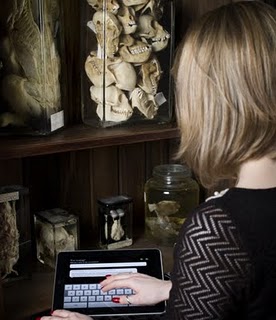The interactive system is designed to be non intrusive while enabling members of the pubic to simply type in their thoughts and interpretation of museum objects and click ‘send’. Their interpretation become part of the objects history and ultimately the display itself via the interactive label system to allow the display of comments and information directly next to the artefacts.
At its heart QRator is an iPad/iPhone and web based system that allows everyone to be a curator and share their views on an exhibition. Visitors can examine an object before leaving their thoughts via an iPad to create a digital, ‘living’ label that subsequent visitors can read and respond to.
By downloading a free application to an iPhone or android phone, visitors are able to see rolling updates to the digital label after they leave the museum, or via twitter. Participants are also able to take part in the conversation online via the QRator site with comments appearing live within the museum.
Content currently covers two museums at UCL; The Grant Museum of Zoology and The Petrie Museum of Egyptology. he Grant Museum of Zoology is one of the oldest natural history collections in England, dating back to 1827. The collection comprises over 68,000 skeletal, taxidermy and wet specimens, covering the whole of the animal kingdom. Many of the species are now endangered or extinct including the Tasmanian tiger or thylacine, the quagga and the dodo. The Grant Museum is the only remaining university zoology museum in London.
The Museum will offer a continual programme of ‘Current Questions’ for visitors to engage in. UCL is taking the opportunity to rethink what a university museum can be; a place not simply for a passive experience but for conversation – a cultural laboratory for the meeting of minds. Positioning the Museum as a place of experimentation, dialogue and debate.


